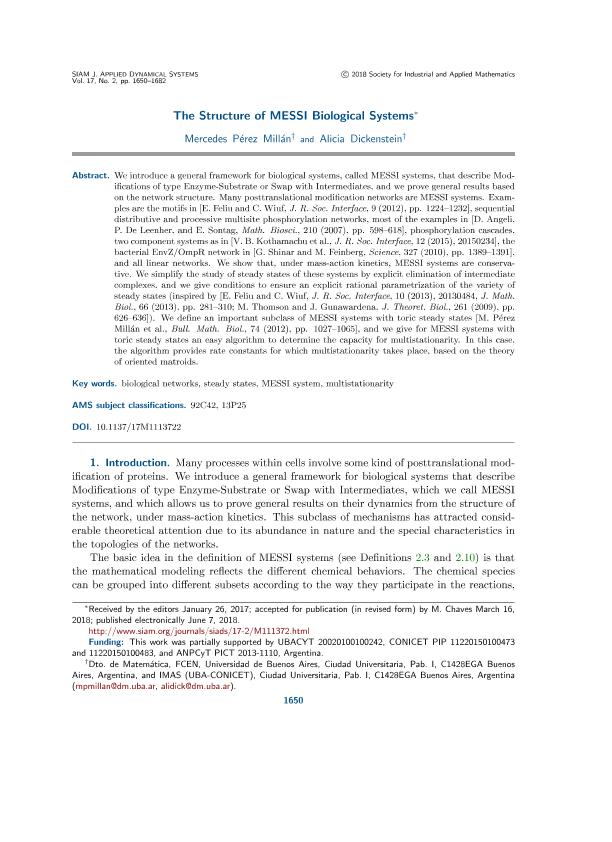Artículo
The structure of MESSI biological systems
Fecha de publicación:
06/2018
Editorial:
Society for Industrial and Applied Mathematics
Revista:
Siam Journal On Applied Dynamical Systems
ISSN:
1536-0040
Idioma:
Inglés
Tipo de recurso:
Artículo publicado
Clasificación temática:
Resumen
We introduce a general framework for biological systems, called MESSI systems, that describe Modifications of type Enzyme-Substrate or Swap with Intermediates, and we prove general results based on the network structure. Many posttranslational modification networks are MESSI systems. Examples are the motifs in [E. Feliu and C. Wiuf, J. R. Soc. Interface, 9 (2012), pp. 1224-1232], sequential distributive and processive multisite phosphorylation networks, most of the examples in [D. Angeli, P. De Leenher, and E. Sontag, Math. Biosci., 210 (2007), pp. 598-618], phosphorylation cascades, two component systems as in [V. B. Kothamachu et al., J. R. Soc. Interface, 12 (2015), 20150234], the bacterial EnvZ/OmpR network in [G. Shinar and M. Feinberg, Science, 327 (2010), pp. 1389-1391], and all linear networks. We show that, under mass-action kinetics, MESSI systems are conservative. We simplify the study of steady states of these systems by explicit elimination of intermediate complexes, and we give conditions to ensure an explicit rational parametrization of the variety of steady states (inspired by [E. Feliu and C. Wiuf, J. R. Soc. Interface, 10 (2013), 20130484, J. Math. Biol., 66 (2013), pp. 281-310; M. Thomson and J. Gunawardena, J. Theoret. Biol., 261 (2009), pp. 626-636]). We define an important subclass of MESSI systems with toric steady states [M. Pérez Millán et al., Bull. Math. Biol., 74 (2012), pp. 1027-1065], and we give for MESSI systems with toric steady states an easy algorithm to determine the capacity for multistationarity. In this case, the algorithm provides rate constants for which multistationarity takes place, based on the theory of oriented matroids.
Palabras clave:
BIOLOGICAL NETWORKS
,
STEADY STATES
,
MESSI SYSTEMS
,
MULTISTATIONARITY
Archivos asociados
Licencia
Identificadores
Colecciones
Articulos(IMAS)
Articulos de INSTITUTO DE INVESTIGACIONES MATEMATICAS "LUIS A. SANTALO"
Articulos de INSTITUTO DE INVESTIGACIONES MATEMATICAS "LUIS A. SANTALO"
Citación
Pérez Millán, Mercedes Soledad; Dickenstein, Alicia Marcela; The structure of MESSI biological systems; Society for Industrial and Applied Mathematics; Siam Journal On Applied Dynamical Systems; 17; 2; 6-2018; 1650-1682
Compartir
Altmétricas




